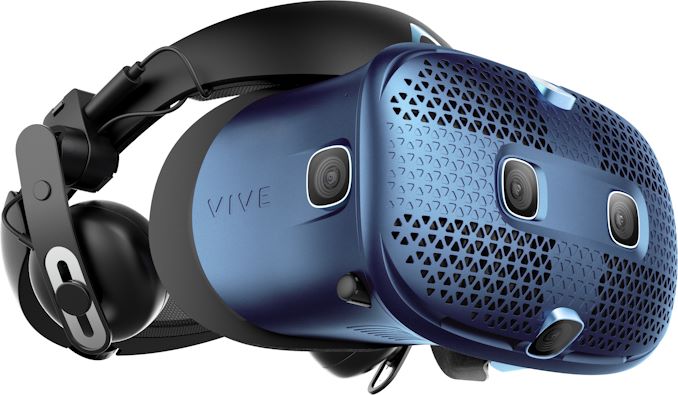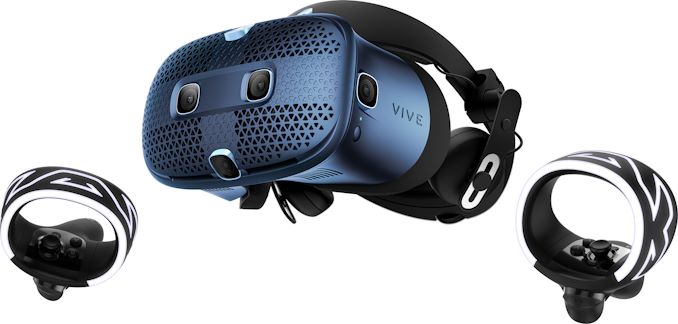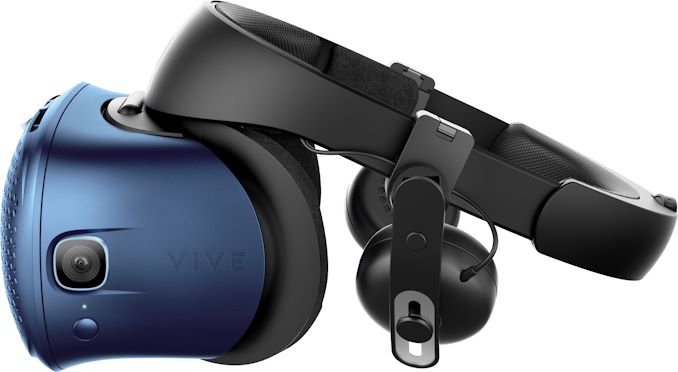HTC Unveils Final Specs & Availability Date of Cosmos VR Headset for PCs
by Anton Shilov on September 13, 2019 11:00 AM EST- Posted in
- VR
- HTC
- Vive
- Vive Cosmos

HTC this week announced final specifications as well as availability date of the Vive Cosmos, its next-generation tethered VR headset, which promises numerous improvements along with modularity for further upgrades. Among the key features of the Vive Cosmos are higher resolution displays, full 6DoF inside-out tracking built around six cameras and integrated sensors, a lower weight, as well as all-new knuckles-style controllers. The headset is available for pre-order now and will ship in early October.
Originally unveiled at CES early this year, the Vive Cosmos head mounted display (HMD) is equipped with two 3.4-inch RGB LCD screens, each offering a per eye resolution of 1440×1700 (2880×1700 combined resolution), a 90 Hz refresh rate, and a 110-degree field of view (officially, this is the same as the original Vive). On which note, HTC has been relatively mum on the optics used, though it has been confirmed that they're continuing to use Fresnel lenses.
As this is a tethered headset by default, in its standard configuration the HMD connects to a host PC using via DisplayPort 1.2 and USB 3.0. Alternatively, the VR HMD can be equipped with a WiGig-based wireless adapter from HTC.
The VR headset comes with a built-in inside-out 6-degree-of-freedom (6DoF) positional tracking enabled by six cameras, a G-sensor, as well as a gyroscope, which is an important distinction from the original Vive (and Vive Pro), as it does not require any external sensors for tracking. This greatly simplifies the setup process and removes some of the friction from using the device, though as a realistic assessment it's unlikely to be quite as stable as using external sensors. Like all HTC Vive HMDs, the Cosmos has its own spatial audio-supporting stereo headphones as well as microphones.
The new headset also comes with brand-new knuckle-style controllers, which are tracked by the HMD as part of its inside-out tracking. The controllers feature touch sensitivity, two application buttons, a trigger, a joystick, a bumper, and a grip button; all the common controls found on current-generation VR controllers. There is one notable caveat about the Cosmos controllers though: they are powered by two AA batteries and cannot be recharged from outside, which means that users will need to swap batteries after they get run down.
A unique capability of the Vive Cosmos is modular design of its front panel, which can be detached and replaced by another one, allowing upgrades and new features to be added. Fittingly, the very first ‘mod’ is the Vive Cosmos External Tracking Mod, and it is designed to allow the headset to be tracked externally using the SteamVR ecosystem's existing Lighthouse base stations (though this also means the Cosmos controllers cannot be used). This one will be available in Q1 2020 for under $200.
The new HTC Vive Cosmos has a lower weight compared to its predecessors, the manufacturer says without elaborating. Meanwhile, the HMD continues to use a headstrap similar to that of the Vive Pro, with a sizing dial and enhanced ergonomics that balance the weight for added comfort.
HTC’s Vive Cosmos VR headset will be launching on October 3rd for $699. However for anyone looking to get started right away, HTC has already started taking pre-orders this week.
Related Reading:
- HTC at CES 2018: Vive Pro VR Headset with Higher-Res Displays, Two Cams, Headphones
- Valve Index VR Headset: 1440×1600 per Eye and 120/144 Hz LCDs
- HP Reverb Virtual Reality Headset: A 4K HMD with 6DOF
- Oculus Rift S VR Headset: An Upgraded Virtual Reality Experience
Source: HTC













32 Comments
View All Comments
DigitalFreak - Friday, September 13, 2019 - link
I'd wait until the reviews are in. The previews are mixed.konbala - Friday, September 13, 2019 - link
Wonder if wireless adapter requires Pro Add-on too or.PeachNCream - Friday, September 13, 2019 - link
That price! Ouch!nandnandnand - Friday, September 13, 2019 - link
Tethered. Not even once.stephenbrooks - Friday, September 13, 2019 - link
I've got an original Vive and this one doesn't seem to be a big enough jump to be worth upgrading to, although if there's a Mk.3 with the same rate of progress it will be.Oxford Guy - Sunday, September 15, 2019 - link
Foveated rendering?It seems to me that VR will never be much to speak of until it has that really down. Not only does it greatly reduce the processing demands, it makes the experience more real. I suppose the trouble is getting the eye tracking speed high enough while maintaining low enough headset cost.
nandnandnand - Sunday, September 15, 2019 - link
I think it is achievable. I saw a paper that used FOVE, a headset with 70 Hz frame rate and 120 Hz eye tracking, and that's years old by now.You might even get away with slower/crummier tracking if you render a higher % of the displays at high res. Then incrementally improve it.
stephenbrooks - Sunday, September 15, 2019 - link
My guess is that by the time eye tracking etc. is widespread in hardware, PC graphics cards will have advanced to the point they can brute-force render the whole scene anyway.What'd really be nice is a wireless video link technology. That would be useful for a lot of things besides VR, but the bandwidth is so big it sounds like we'll need to use lasers rather than wi-fi to do it.
nandnandnand - Sunday, September 15, 2019 - link
Well, your guess is wrong. The target is 16K resolution, 240-1000 FPS. And eye tracking is mostly solved. See FOVE or Vive Pro Eye.Standalone headsets are preferred, so it would have to render 16K on a SoC. Foveated rendering could make that possible by decreasing pixels rendered per frame by over 90%.
If you want your beefy computer to render instead and transmit wirelessly using WiGig 2.0/3.0, guess what? Foveated rendering would dramatically decrease the necessary data rate.
So it all comes back to foveated rendering. Amazing you didn't make the connection.
stephenbrooks - Monday, September 16, 2019 - link
The Vive just took several years to move from 1.2K to 1.7K pixels, I think you'll be waiting a bit for 16K. Generally, I'd expect screen res, graphics card capability and display link bandwidth to move in sync (reason: the rest of the graphics market).So by some time in the 2030s when there are 16K screens, I'd expect to be able to brute force render them on my PC, every pixel.
Standalone headsets will keep suffering from being either too heavy, too hot, poor battery life or low performance. See how bulky gaming laptops are? It's basically the same problem.